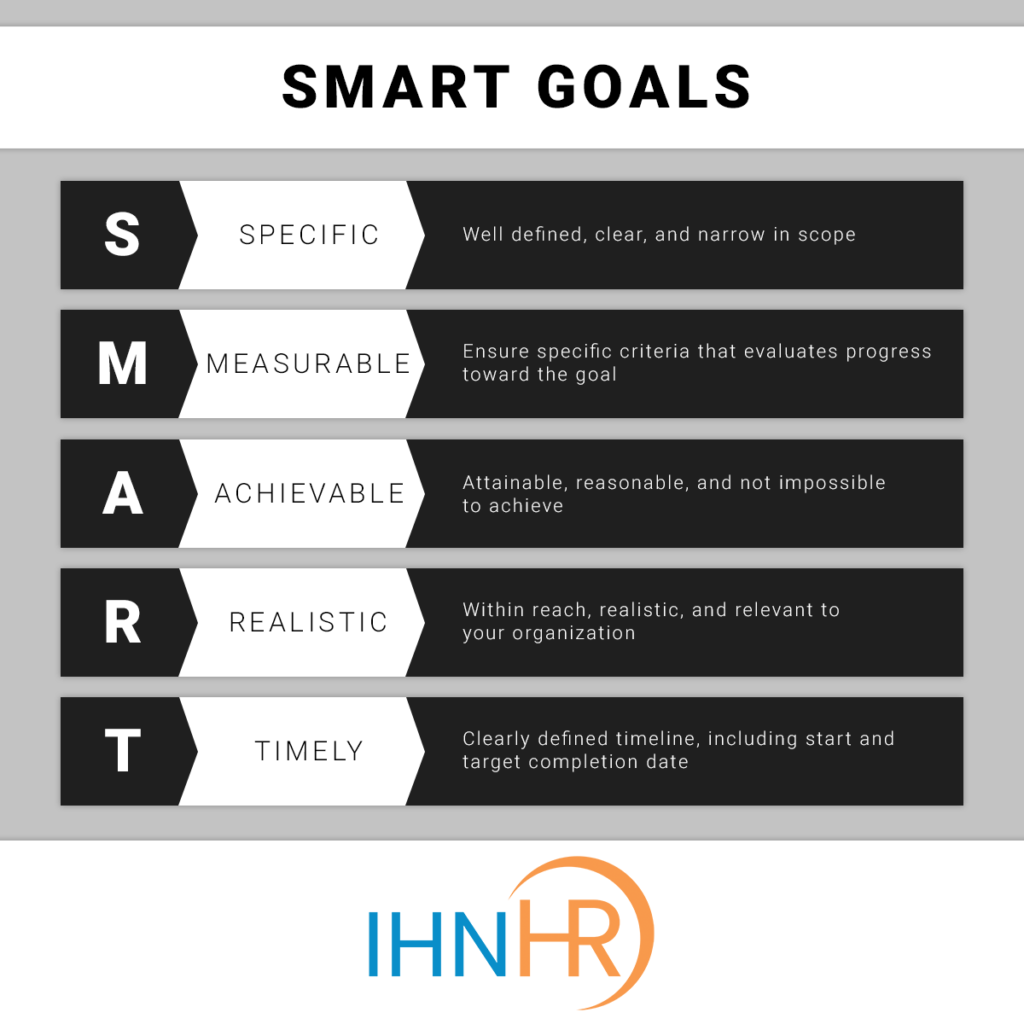The Strategic Planning Process

Step 3: Strategy Implementation
Once you have Steps 1 and 2 down, the time has come to put your strategic plan into action!
You’ve poured intention into every building block, scanning the landscape… looking within… formulating strategy. Now execution begins. This is where the rubber meets the road, and it just so happens to be the most exhilarating part of your strategic journey!
In the following pages, we’ll explore how to activate strategy across your entire organization. Translating plans into concrete results takes focus and follow-through, but it can be done.
And it can be done best when you break it down into five key stages…
Stage 1: Setting SMART Goals
Well-defined short-term goals put vision into action, fueling strategy execution by creating focus and accountability. They provide milestones and motivation to achieve outcomes, unifying team efforts and empowering everyone involved to convert strategy into tangible outcomes.
We’ve already covered what SMART means in previous steps. But as a reminder, you want to make your goals Specific, Measurable, Achievable, Relevant, and Timebound.
This encourages you to get precise, detailing how much of what you need specifically… reaching beyond your comfort zone without breaking any backs (or banks)… aligning with strategic priorities and laddering up to your vision… and establishing a defined completion date since urgency drives action.
Limit yourself to 5-8 critical goals. This concentrated focus on what matters most will help you drive results, especially when you check on your progress at least quarterly.
Oh, and for the record, you’ll want to celebrate achievement along the way! Recognition reinforces goals and breeds more success. So if you want to keep the wins coming, keep the congratulations flowing whenever possible.
Stage 2: Select Key Performance Indicators
As we outlined in our recent blog post, key performance indicators (KPIs) measure progress towards goals. They quantify success across metrics like quality, cost, cycle time, and satisfaction.
Most organizations attempt to consolidate their KPIs into 3-5 measurements. And this makes sense. Any more, and it becomes difficult to manage and therefore to bring clarity and focus.
Also be sure to allow departmental leadership freedom to develop their own strategies to achieve set goals. For instance, if an organization wants to reduce operating costs by 20%, a good HR professional could support that with the KPI “reduce time to hire by 10 days” or “reduce turnover by 10%.” Either way (or implementing both at the same time) contributes to the bigger intended picture.
KPIs should always be based on your mission, vision, values, goals, and objectives. Even with that guidance, it opens a plethora of choices for leadership to decide between. To help narrow them down, consider the following examples and determine the vital KPIs that best reflect your organization’s unique strategic priorities, such as:
- Fundraising numbers and sources
- Program impact, reach, and outcomes
- Customer satisfaction scores
- Productivity, efficiency, and cycle times
- Talent retention percentages
- Brand awareness and market shares.
Display your KPIs on dashboards to monitor progress on a monthly basis, drilling into dips to diagnose issues and correct them quickly. And as for when you hit KPI milestones, celebrate! This reinforces achievement behaviors.
Stage 3: Establish Goals to Departments
Once you’ve got your KPIs determined and ready for implementation, get ready to involve all department heads in the execution. You should break down organization-wide goals into 12-month goals per division, with each one building up your larger business or nonprofit. Creating unified departmental goals ensures all parts of your organization work in harmony toward a shared outcome or outcomes.
After making sure to properly inform everyone about what the KPIs are, let them know that monitored measurements are designed to contribute to their success and will be built into the annual review process. As each department leader rolls them out, discuss how each department uniquely contributes to the strategy. Where do they add the most value? How does their work ladder-up toward your greater mission? Once you have questions like those figured out, refine draft department goals based on their input to ensure alignment and commitment.
Most organizations have a formalized review process to assess these results, and I would highly encourage it for you too. Typically a quarterly practice, it should involve senior leadership meeting to discuss the progress, then taking any status updates and findings to their employees.
As with higher-level KPIs, make sure to acknowledge when and where individual departments are meeting their goals or even exceeding them. And provide support and resources to accelerate work streams that are lagging.
Stage 4: Establish Department Goals to Individuals
Sometimes, you need to take goals to an even more specific level, in which case, you’ll want to tailor department goals to individual employee goals.
Discuss how each person’s specific role contributes to his or her department’s objectives as well as the organization-wide strategy. Where can they uniquely contribute? How should this be done?
Establishing these specified instructions should happen with the specific individuals fully involved and engaged. Seek their input and perhaps their teammates as well – all with the intention of empowering your various teams to finetune their goals. Well-aligned employee-specific goals build engagement, enhance productivity, and create accountability. People work smarter when they see their contribution, knowing that they matter and that they are not just mindless cogs in a machine.
You’ll want to do plenty of follow-ups here. As a leader, meeting with your team members through direct reports is critical. Check in on individual goal progress during monthly one-on-ones. Modify goals if roles change, and offer support to remove performance barriers.
When everyone knows what they’re doing and why – and feels useful and appreciated in the process – good things tend to come together.
Stage 5: Align Budget to Goals
The final stage of Step 3 involves reassessing your finances one more time. An annual budget aligned with strategic goals makes sure that resources are flowing to the right places at the right times to keep the organization running as planned.
Analyze your current budget and identify gaps between existing funding and strategic needs. Then shift and reprioritize allocations accordingly. While you’re at it:
- Build financial models to assess initiative returns on investment (ROI).
- Eliminate low performers and double down on winners.
- Conduct deep-dive explorations of expenses to find savings through improved efficiency.
- Repurpose savings into strategic priorities.
- Reforecast regularly as your strategy evolves.
Just make sure to maintain continuity long enough for returns on initiatives to manifest themselves.
Receive Blog Updates
|
|
Thank you for Signing Up |




